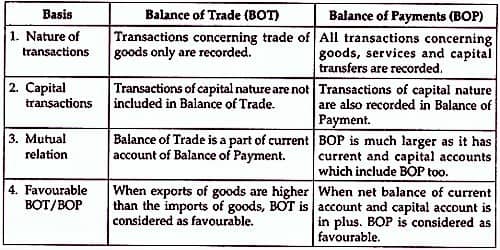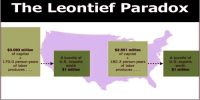The balance of trade is the difference between the values of exports and imports of visible goods of a country during a given period of time. If a value of visible items of exports exceeds then the value of visible goods imports then the balance of trade is said to be favorable and vice versa. It simply deals with the export and import of goods.
Balance of Payment is a systematic record of all economic transactions which take place among the individuals of a country and the rest of the world. It includes the balance of trade, the balance of services, balance of unilateral transfers, and balance of payment on capital account.
Difference between Balance of Payment and Balance of Trade –
Balance of payment – It is the sum total of a balance of trade, the balance of services, the balance of unilateral transfers, and capital account. It is a true indicator of the economic performance of an economy.
- Balance of payment is the record value of all the transaction between a countries residence and all the rest of the world.
- It includes the account of visible, invisible and imports. It also includes current account, capital account, and reserve.
- It is a broad term; it is a complete account of international business. It captures all the monetary transaction performed internationally by the country during a course of time.
- In accountancy meaning, it gets complete balance always. Both the receipts and payment sides tallies.
- It compresses by active and inactive elements. Capital and unilateral transfers are included in the balance of payments.
- If the balance of payment is positive terms of trade is negative. The net effect of the balance of payments would always be zero.
- It reflects a clear picture of the economy and provides a holistic picture.
Balance of payments can be calculated by adding the balance of payments at the current account and balance of payments at a capital account or by finding out the net balance between inflow of foreign exchange and outflow of foreign exchange.
Balance of trade – It can be defined as the net balance of the export of goods and the import of goods in a given period of time. It is not a true indicator of economic relations or economic prosperity of a country.
- The difference between the value of visible commodity exports and imports is known as terms of trade.
- It includes only the accents of visible imports and exports.
- It is narrow or smaller term; it is a part of the balance of payment or exchange balance.
- It hardly gets complete balance. It can be Favorable, Unfavorable or balanced.
- It compresses by active elements. Capital and unilateral transfers are not included in the balance of trade.
- If the balance of payment is positive terms of trade is negative. The net effect of the balance of trade can be positive, negative, or zero.
- It reflects a clear picture of a country; it portrays a partial picture of foreign exchange.
Balance of trade can be calculated by deducting the value of imports of goods from the value of exports of goods.
Finally, understanding the balance of trade and balance of payments is moderately significant if you want to realize foreign exchange. Balance of payments is the overall record of all economic transactions of a country with the rest of the world. Balance of trade is the difference in the value of exports and imports of only visible items.















